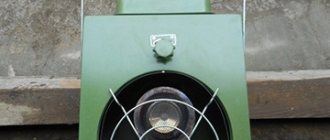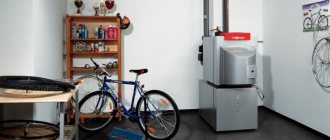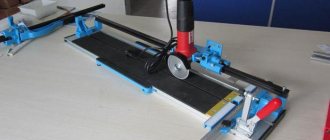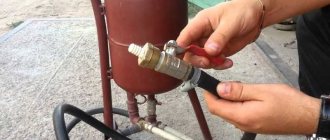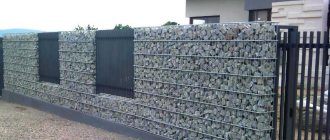The need for heating in a garage rarely causes controversy: motorists understand perfectly well how important it is to take care of the condition of the car, and they themselves do not want to freeze during inspections and repairs of equipment.
The main issue that needs to be resolved is the selection of the appropriate type of heating. A good option is a miracle diesel stove - the unit is easy to assemble and economical to operate. And these are important criteria for organizing garage heating.
Before you decide to assemble a stove, you need to understand its structure and operating principle, don’t you agree? In the article, we outlined the identified points in detail, and also provided several options for assembling a home-made unit. Step-by-step instructions will help you build a stove and organize efficient heating of your garage.
Type of autonomous heaters using diesel fuel
According to established terminology, autonomous heating units using diesel fuel are divided into the following types:
- small autonomous diesel stove;
- powerful diesel heat furnace (heat gun);
- homemade autonomous diesel stove;
- stove - dripper, running on diesel fuel.
Any diesel stove has its own advantages and disadvantages. To evaluate each of them, you need to understand the characteristics of such devices.
Rules for the safe use of heaters
It is known that the garage is a place of increased fire danger.
And given that it is planned to be heated with liquid fuel equipment, it is worth taking the issue of placing the heating unit with full responsibility:
- The oven is located in a place where there are no drafts. Also, it should not be near flammable liquids and objects.
- There should be enough free space around the heating device - at least within a radius of 50 cm.
- The most optimal would be to place the structure on a sheet of asbestos, metal or other non-combustible material.
- Fuel, wicks and other consumables should be stored as far as possible from sources of fire.
Oven characteristics
All types of autonomous diesel stoves can be divided according to the following criteria:
- heating method;
- design diagram;
- allocated power;
- diesel fuel consumption rates;
- possibility of connecting additional heating devices or systems;
- weight and size characteristics.
Potbelly stove
Based on the heating method, they can be divided into two large categories:
- autonomous devices using direct heating;
- devices using indirect heating.
A feature of direct heating devices is the absence of an equipped chimney. They are called "potbelly stoves".
Indirect heating devices are most widespread.
A homemade diesel stove is assembled according to one of the following schemes:
- double-circuit or as it is called gas-air;
- wick;
- drip;
- using steel sheets;
- using an ordinary gas cylinder.
Homemade diesel stove
In terms of heat output power and diesel fuel consumption rate, factory-made units start from 2.5 kW with a consumption of 180 milliliters of diesel fuel per hour and up to 20 kW with a productivity of 550 m3 per hour. Diesel fuel consumption increases to 1.5 liters. Such units are called heat guns.
Possibility of connecting additional heating systems, such as air ducts. Depending on the characteristics, the continuous operation time changes. This time varies from 6 to 28 hours of operation without refueling.
Self-production
A self-assembled diesel fuel burner is calculated exactly for the requirements of the garage space. Efficiency and cost-effectiveness are increased. The structure is assembled using three technologies:
- device from a gas cylinder;
- drip type heater;
- heating device made of metal sheets.
Before starting work, get acquainted with the design options and choose the optimal one.
- LiveJournal
- Blogger
Some features of this oven
The features of a homemade diesel stove can be divided into two categories:
- manufacturing features;
- Features of application.
Manufacturing features are determined by the choice of design of such a stove. This will require the selection of a certain material (appropriate steel: sheet, angle, pipe), certain finished products or home-made production (nozzles, pipes, chimneys and air ducts), containers for diesel fuel. The need to use appropriate tools and metalworking equipment (drill, grinder with a set of cutting wheels, welding machine) and hardware for attaching individual parts of a homemade stove.
Application features include: the specifics of igniting such a stove, organizing the removal of combustion products. Using diesel fuel as fuel will require periodic maintenance of the existing nozzle and burner. This is caused by the presence of sulfur in diesel fuel.
If you use a diesel fuel stove in which the fuel flows by gravity, it is necessary to place the diesel fuel tank at a certain distance above the burner itself to prevent its uncontrolled heating.
What objects can be heated by a miracle stove?
Modern stoves using diesel fuel as fuel, regardless of their shape and design, are capable of heating various rooms. They successfully cope with the task of maintaining comfortable temperature conditions in the following buildings:
- country houses that do not have communications;
- separate rooms of residential suburban buildings;
- additional country buildings (sheds, outbuildings);
- extensions, basements, basements;
- garages, workshops;
- free-standing greenhouses and greenhouses;
- They can be used to heat individual tents and campsites.
Popular models
Affordable, compact, economical, and not polluting the air with soot and harmful substances - solargas autonomous heaters are just such devices.
They have a simple design, are not picky about the quality of fuel, are made of stainless steel, therefore they are heat resistant, resistant to corrosion and do not rust. The characteristics of several models are shown in the table.
PO-1.8
PO-2.5
S-4.0
PO-5.0
Aeroheat HA S2600 BOXER
Aeroheat HA S2600 BOXER heaters use regular diesel fuel or kerosene to operate. They have great heat transfer and are able to heat a room of up to 30 square meters. meters.
- power -2.6 kW;
- fuel consumption - 0.2 l/h;
- fuel tank capacity - 2.5 l;
- weight - 4.5 kg;
- dimensions - 35 x 29 x 27 cm;
- burning time at 1 filling - 10-14 hours;
Master B35
Heat guns Master B35 CED (Italy) are of high quality. They are easy to use, do not create noise during operation, and ensure waste-free combustion of diesel fuel without polluting the air with combustion waste. The approximate price of products is from 18 to 20 thousand rubles.
- Efficiency - almost 100%;
- power - 10 kW;
- fuel consumption - 0.6 l/h;
- tank capacity - 15 l;
- air flow - up to 280 m³/h.
More powerful heating devices AOZH - 8.7 brand TRITON - are used for heating a room with an area of 60 - 70 m2.
- power -8.7 kW;
- fuel consumption - 0.18 - 0.8 l/h;
- fuel tank capacity - 2.5 l;
- weight - 45 kg;
- dimensions - 500 x 450 x 780 mm;
- burning time on 1 fuel fill is 10-14 hours.
Precautionary measures
The use of homemade diesel stoves is always associated with the presence of an open fire. Therefore, certain precautions must be taken. They will help you avoid many troubles and even tragedies.
Garage stove
These precautions are fire safety measures:
- the stove must not be installed in places where drafts are possible (they contribute to the activation of combustion of the mixture);
- It is necessary to create a space around the stove (approximately 1.5 meters) free from combustible and flammable objects (this must be especially ensured in a garage or workshop);
- provide access to a fire extinguisher;
- the length of the chimney must exceed 4 meters;
- After using the stove, it is necessary to carry out its cleaning and maintenance;
- For residential premises, it is advisable to use factory-made diesel fuel stoves that have special permitting certificates.
Design of heating equipment running on diesel fuel
A factory or homemade diesel garage heater is multifunctional equipment.
It can be used as the main, additional or alternative source of thermal energy if there is a heating system already installed in the room. If necessary, the stove can be used as a hob: food can be quickly heated on it and the kettle can boil.
Important! Diesel heaters are strictly prohibited from being installed in poorly ventilated areas. And if during operation the stove almost does not emit harmful substances into the atmosphere, then during ignition and extinguishing the fire, emissions of a small amount of compounds hazardous to human health are observed in the smoke
Many models of diesel stoves can operate not only on DP, but also on other types of liquid fuel. Judging by reviews from consumers and some experts, the best option in this case is kerosene. But due to a huge desire to save money, people prefer diesel fuel.
For reference! Diesel stoves are very economical: based on practice, one tank refill is enough for continuous operation of the heater for 6-28 hours. Take-off time is regulated by the design of the model and the volume of the fuel tank.
The operating principle of a heat gun.
Heaters of this type consist of a fuel tank - in most cases it is removable, equipped with a valve, a replaceable block with a wick, an adjusting screw, a reflector and the burner itself. All structural elements are located in a common housing.
If we are talking about homemade equipment, then a barrel, a tank welded from sheets of heat-resistant steel, or even a used gas cylinder will work as a body.
The burner is placed in the center of the structure. Fuel is supplied to it from a tank located at the rear wall of the device body. In order to achieve the required temperature, an adjustment screw is used. And due to the reflector included in the design, quick and reliable heating of the room is ensured.
If you plan to purchase a factory heater, then it is better to give preference to compact models weighing 10-20 kg. Such equipment, if necessary, can be easily moved to another location using your own resources.
On what principle does it work?
The main physical principle on which almost all diesel stoves operate is the principle of converting combustion energy into thermal energy. Diesel fuel usually flows by gravity into the chamber, where it is mixed with air and heated. This mixture then enters the combustion chamber.
Miracle stove device
In this chamber, when it burns, it heats either the walls or a special heating element, which serves as a heat exchanger. Combustion products are discharged through a special chimney to the outside. In addition to the stove itself, such a chimney also serves as a heat exchanger and heats the surrounding air in the room.
Comparisons
If we compare heating methods in general, excluding capital stoves and electrical appliances from the list, then we simply cannot find a better option than diesel heating. The resulting thermal energy is cheap. This is the most rational way to heat garage buildings. The infrared method of heating cold air to the required positive temperature may compete. An infrared heater from a good manufacturer can heat the air in a garage to plus 20 C°. In this case, thermal energy is distributed evenly throughout the air volume of the “motorhome”. The infrared heat generator does not produce odors. In this respect it is inert. But it's expensive. Today, electricity is constantly becoming more expensive. And such a heater likes to “eat” a lot.
During the final assembly process, it is necessary to protect the ends of the heat generator with mesh or screens. The outlet gas temperature can reach plus 250 C°. You might accidentally get burned. Therefore, for safety reasons, it is recommended to close the hot air outlets with grilles.
Storing a vehicle in a heated and dry garage significantly extends its service life, and also allows you to significantly reduce the cost of purchasing antifreeze and car maintenance.
In addition, in a dry and warm room you have the opportunity to maintain your vehicle yourself. A diesel heater will help organize inexpensive, but at the same time high-quality heating in the garage. Now we’ll try to figure out how such a miracle stove works and how you can assemble it on your own.
Designing a stove with your own hands
For independent design, you must have minimal knowledge in the field of gas thermodynamics (to understand how the formation and combustion of a flammable mixture of diesel fuel and oxygen occurs), and be able to understand basic drawings. It is advisable to have basic skills in the field of ferrous and non-ferrous metal processing (cutting, drilling and welding technology). If you don’t have such experience, you can always turn to specialists.
A diesel stove with your own hands can be made in a garage or home workshop.
Construction from a conventional gas boiler
You can use elements of an old gas boiler as a housing. The boiler body must be cut into two halves. One will be the bottom of the stove, the other will be the top. The nozzles present in it must be expanded to ensure a free flow of diesel fuel into the mixing chamber and further into the combustion chamber.
Homemade stove from a gas boiler
The air duct system can be converted into a chimney exhaust. All that remains is to place the diesel fuel tank and the stove is ready.
Gas cylinder heater
An unused gas cylinder can be used as the body of the future stove. Before using it, you must ensure that it is empty. In addition to the cylinder, you will need two pipes approximately 4 meters long and an outer diameter of about 100 mm, a container for storing diesel fuel (on average 10 to 15 liters), two copper tubes (for the production of a burner). The support should be made from steel corners with a 200mm shelf. In addition to the material, you will need tools: a drill and metal drills, a grinder (grinder) with cutting wheels, any welding machine.
Using a grinder, the balloon is cut into two equal parts. The upper part will be the lid of the future stove, the lower part will serve as a combustion chamber. To ensure stability of the entire structure, metal corners are welded from below, which are the legs of the future stove.
A hole is made in the upper half. An exhaust pipe is installed in it. It must be securely welded. Make sure that it is positioned strictly vertically. A hole is made in the pipe. It functions as an air supply regulator.
Stepping back about 10 cm from the pipe, make another hole up to 3 mm in size. There must be at least ten such holes. The latter should be no more than 50 centimeters away from the welding point. In addition, a hole with a diameter of up to 8 centimeters is prepared in the upper part for filling diesel fuel. A hole 5–8 cm in size is made in the upper part of the cylinder for filling fuel.
Drip stove
They are quite economical and easy to manufacture. For example, to obtain a power of 10 kW, a diesel fuel consumption of only 0.6 liters per hour is required. By increasing the size of the structure, the heat transfer power can be increased to 20 kW.
The manufacturing technology of a diesel-powered drip stove does not present any particular technical difficulties. First, calculate the dimensions of the future unit. The calculation is made based on the following considerations. To heat a room of 9 square meters. m, a stove whose dimensions are 30x30x45 cm will be sufficient. These dimensions allow you to calculate the volume of the stove itself. Most often, ready-made structures are used and not necessarily rectangular. For small stoves, the lower parts of fire extinguishers are used; for more powerful stoves, the bottom of metal barrels is used.
The supply of diesel fuel is organized using elements of a medical burner. The rubber hose in it is attached to a specially prepared copper tube. This tube is bent at a right angle. Then it is secured with a clamp or a specially prepared fastener. As a wick, you can use a handy rag, which is pre-impregnated with diesel fuel.
Homemade drip stove
The principle of operation of such a stove is to constantly wet the wick with diesel fuel, which flows by gravity through a hose and tube from a container with diesel fuel.
A door is made in the stove body, and on top there is a hole for supplying a copper tube.
Stove made of steel sheets
It is shaped like two metal disks. Between them there is a steel pipe. Several holes are drilled in it. They are designed to allow external air to enter from below and remove harmful combustion products.
Typically, such a unit has fairly compact dimensions. The specific design allows us to consider it quite safe. Another advantage of such stoves is their efficiency. This is determined by the fact that the fuel mixture burns completely and the most efficient heat transfer occurs.
To manufacture such a furnace, you will need sheet steel with a thickness of at least 5 mm and a steel pipe. It needs to be cut into two shorter pipes and two elbows made. They must be made in such a way that it is possible to insert one into the other. After connecting these elements, the chimney structure is obtained. I make two containers from steel. One, the lower one, serves as the firebox for the stove itself, the second, the upper one, is the fuel tank. The tank size is determined by the manufacturer himself. Usually its volume does not exceed 12 liters. This is due to the convenience of filling diesel fuel.
The placement of the tank above the level of the combustion chamber is based on the principle of diesel fuel supply. It flows by gravity. In a special chamber, the diesel fuel is mixed with air and heated. Thus, a flammable mixture is formed. Next, the combustible mixture enters the combustion chamber. During combustion, the coil heats up in it. This spiral acts as a heating element. When working properly, it heats up to a temperature of about 800 °C.
Advantages and disadvantages
Any option for creating or purchasing a stove to maintain the desired temperature in the garage has both positive and negative sides. There is no need to stop at the first option that comes to you.
Only by examining and analyzing them, as well as taking into account all the positive and negative aspects, can you finally decide on the choice in each specific situation.
The positive points are:
- Low cost of the fuel used and its low consumption compared to wood or coal.
- Low amount of harmful emissions into the room and atmospheric air. But it is worth remembering about safety; any process of burning hydrocarbons is accompanied by the release of a life-threatening, insidious and invisible gas - carbon monoxide, which has no odor. Therefore, issues of room ventilation should be treated with great responsibility.
- Availability and low cost of materials for the construction of such a furnace; all you need is a little metal.
- The ease of manufacturing such a stove; even a person who is far from the intricacies of metalworking can cope with such work. All you need is to be able to use a grinder and a welding machine.
- Possibility of reliable operation in cold and warm seasons.
- Small dimensions of the heating unit.
There are fewer negative aspects, but they also exist:
- The stove emits the smell of burnt petroleum products, and the effect of carbon monoxide on the human body was described above.
- The heating device needs to be cleaned regularly, at least once a week.
- If a diesel stove is not properly maintained, it often fails.
- Electrical heating appliances and other hot surfaces should not be used near such a stove.
